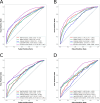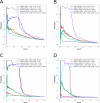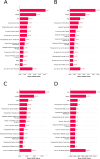Machine learning models on a web application to predict short-term postoperative outcomes following anterior cervical discectomy and fusion
- PMID: 38773464
- PMCID: PMC11110429
- DOI: 10.1186/s12891-024-07528-5
Machine learning models on a web application to predict short-term postoperative outcomes following anterior cervical discectomy and fusion
Abstract
Background: The frequency of anterior cervical discectomy and fusion (ACDF) has increased up to 400% since 2011, underscoring the need to preoperatively anticipate adverse postoperative outcomes given the procedure's expanding use. Our study aims to accomplish two goals: firstly, to develop a suite of explainable machine learning (ML) models capable of predicting adverse postoperative outcomes following ACDF surgery, and secondly, to embed these models in a user-friendly web application, demonstrating their potential utility.
Methods: We utilized data from the National Surgical Quality Improvement Program database to identify patients who underwent ACDF surgery. The outcomes of interest were four short-term postoperative adverse outcomes: prolonged length of stay (LOS), non-home discharges, 30-day readmissions, and major complications. We utilized five ML algorithms - TabPFN, TabNET, XGBoost, LightGBM, and Random Forest - coupled with the Optuna optimization library for hyperparameter tuning. To bolster the interpretability of our models, we employed SHapley Additive exPlanations (SHAP) for evaluating predictor variables' relative importance and used partial dependence plots to illustrate the impact of individual variables on the predictions generated by our top-performing models. We visualized model performance using receiver operating characteristic (ROC) curves and precision-recall curves (PRC). Quantitative metrics calculated were the area under the ROC curve (AUROC), balanced accuracy, weighted area under the PRC (AUPRC), weighted precision, and weighted recall. Models with the highest AUROC values were selected for inclusion in a web application.
Results: The analysis included 57,760 patients for prolonged LOS [11.1% with prolonged LOS], 57,780 for non-home discharges [3.3% non-home discharges], 57,790 for 30-day readmissions [2.9% readmitted], and 57,800 for major complications [1.4% with major complications]. The top-performing models, which were the ones built with the Random Forest algorithm, yielded mean AUROCs of 0.776, 0.846, 0.775, and 0.747 for predicting prolonged LOS, non-home discharges, readmissions, and complications, respectively.
Conclusions: Our study employs advanced ML methodologies to enhance the prediction of adverse postoperative outcomes following ACDF. We designed an accessible web application to integrate these models into clinical practice. Our findings affirm that ML tools serve as vital supplements in risk stratification, facilitating the prediction of diverse outcomes and enhancing patient counseling for ACDF.
Keywords: ACDF; Artificial intelligence; Machine learning; Outcome prediction; Personalized medicine; Precision medicine; Spine surgery; Web application.
© 2024. The Author(s).
Conflict of interest statement
The authors declare no competing interests.
Figures






Similar articles
-
Precision medicine for traumatic cervical spinal cord injuries: accessible and interpretable machine learning models to predict individualized in-hospital outcomes.Spine J. 2023 Dec;23(12):1750-1763. doi: 10.1016/j.spinee.2023.08.009. Epub 2023 Aug 23. Spine J. 2023. PMID: 37619871
-
Development and internal validation of machine learning models for personalized survival predictions in spinal cord glioma patients.Spine J. 2024 Jun;24(6):1065-1076. doi: 10.1016/j.spinee.2024.02.002. Epub 2024 Feb 15. Spine J. 2024. PMID: 38365005
-
Personalized Prognosis with Machine Learning Models for Predicting In-Hospital Outcomes Following Intracranial Meningioma Resections.World Neurosurg. 2024 Feb;182:e210-e230. doi: 10.1016/j.wneu.2023.11.081. Epub 2023 Nov 24. World Neurosurg. 2024. PMID: 38006936
-
Utility of Machine Learning, Natural Language Processing, and Artificial Intelligence in Predicting Hospital Readmissions After Orthopaedic Surgery: A Systematic Review and Meta-Analysis.JBJS Rev. 2024 Aug 22;12(8). doi: 10.2106/JBJS.RVW.24.00075. eCollection 2024 Aug 1. JBJS Rev. 2024. PMID: 39172864
-
Optimization of diabetes prediction methods based on combinatorial balancing algorithm.Nutr Diabetes. 2024 Aug 14;14(1):63. doi: 10.1038/s41387-024-00324-z. Nutr Diabetes. 2024. PMID: 39143066 Free PMC article. Review.
Cited by
-
Predicting early return to sport after periacetabular osteotomy : a machine-learning approach.Bone Jt Open. 2025 Jun 1;6(6 Supple B):33-42. doi: 10.1302/2633-1462.66.BJO-2024-0257.R1. Bone Jt Open. 2025. PMID: 40449551 Free PMC article.
-
Predictive Value of Social Determinants of Health on 90-Day Readmission and Health Utilization Following ACDF: A Comparative Analysis of XGBoost, Random Forest, Elastic-Net, SVR, and Deep Learning.Global Spine J. 2025 Apr 2:21925682251332556. doi: 10.1177/21925682251332556. Online ahead of print. Global Spine J. 2025. PMID: 40173192 Free PMC article.
-
Using an interactive web application to identify pre-exposure prophylaxis adherence among men who have sex with men.Int J Clin Health Psychol. 2024 Jul-Sep;24(3):100490. doi: 10.1016/j.ijchp.2024.100490. Epub 2024 Aug 8. Int J Clin Health Psychol. 2024. PMID: 39220117 Free PMC article.
-
MRI-Based Machine Learning and Radiomics Methods for Assessing Spinal Cord Function in Patients with Mild Cervical Spondylotic Myelopathy.Bioengineering (Basel). 2025 Jun 17;12(6):666. doi: 10.3390/bioengineering12060666. Bioengineering (Basel). 2025. PMID: 40564482 Free PMC article.
References
-
- Saifi C, Fein AW, Cazzulino A, Lehman RA, Phillips FM, An HS, et al. Trends in resource utilization and rate of cervical disc arthroplasty and anterior cervical discectomy and fusion throughout the United States from 2006 to 2013. Spine J. 2018;18:1022–9. doi: 10.1016/j.spinee.2017.10.072. - DOI - PubMed
MeSH terms
LinkOut - more resources
Full Text Sources
Medical

